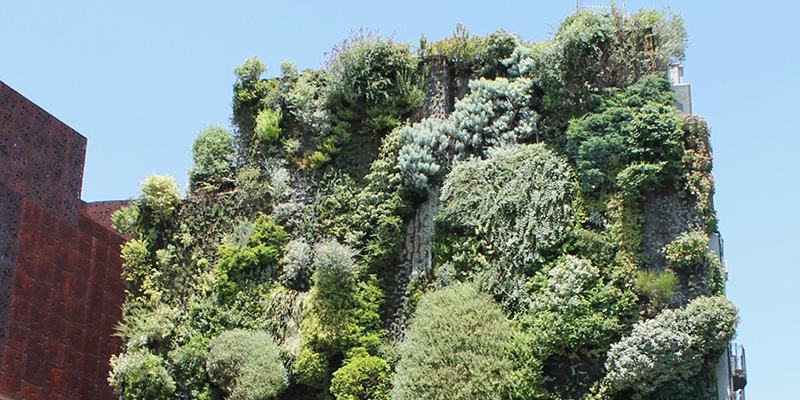A Case Study of a Tube House in Vietnam
Downloads
DOI:
https://doi.org/10.7480/jfde.2019.2.3819Keywords:
green facade, thermal performance, cooling demandAbstract
Traditional architecture has often applied greenery in the design to improve the thermal performance of indoor spaces. Such a bioclimatic approach is not often seen in the contemporary tube houses of Vietnam. Vietnamese architects recently started to focus more on greenery solutions for housing projects. However, the quantitative effects of plants on the building performance has not yet been investigated in Vietnam. This paper reports on an experiment to quantify the benefits of a vertical greening system for thermal performance and energy saving. A typical tube house in Hanoi was selected and two similar rooms were monitored during July and August, 2018. One of the rooms’ façades was covered by the climbing plant Bougainvillea. Outdoor and indoor temperature and energy for air-conditioning were measured for the two rooms to quantify the effect of the greenery on the existing aluminium shading device and a bare window. Results for the green façade showed that the difference between outdoor and indoor temperature can be as high as 8°C. In addition, the climbing plants helped to reduce the indoor temperature by around 1°C and thus cooling energy was saved by up to 35%.
How to Cite
Published
Issue
Section
License
Copyright (c) 2021 Phan Anh Nguyen, Regina van Bokel, Andy van den Dobbelsteen

This work is licensed under a Creative Commons Attribution 4.0 International License.
Authors or their institutions retain copyright to their publications without restrictions.
References
Alexandri, E., & Jones, P. (2008). Temperature decreases in an urban canyon due to green walls and green roofs in diverse climates. Building and Environment, 43(4), 480–493. https://doi.org/10.1016/J.BUILDENV.2006.10.055
Architects, V. T. N. (n.d.). Green Renovation. Retrieved May 7, 2019, from http://votrongnghia.com/projects/green-renovation/
Chen, Q., Li, B., & Liu, X. (2013). An experimental evaluation of the living wall system in hot and humid climate. Energy and Buildings. https://doi.org/10.1016/j.enbuild.2013.02.030
Coma, J., Pérez, G., de Gracia, A., Burés, S., Urrestarazu, M., & Cabeza, L. F. (2017). Vertical greenery systems for energy savings in buildings: A comparative study between green walls and green façades. Building and Environment. https://doi.org/10.1016/j.buildenv.2016.11.014
Coma, J., Pérez, G., Solé, C., Castell, A., & Cabeza, L. F. (2014). New green façades as passive systems for energy savings on Buildings. Energy Procedia. https://doi.org/10.1016/j.egypro.2014.10.049
Dahanayake, K. W. D. K. C., & Chow, C. L. (2017). Studying the potential of energy saving through vertical greenery systems: Using EnergyPlus simulation program. Energy and Buildings. https://doi.org/10.1016/j.enbuild.2016.12.002
Dunnett, N., & Kingsbury, N. (2004). Planting green roofs and living walls LK - https://tudelft.on.worldcat.org/oclc/53814556. In TA - TT -. Retrieved from http://catdir.loc.gov/catdir/toc/ecip0410/2003024231.html
Haggag, M., Hassan, A., & Elmasry, S. (2014). Experimental study on reduced heat gain through green façades in a high heat load climate. Energy and Buildings. https://doi.org/10.1016/j.enbuild.2014.07.087
Köhler, M. (2008). Green façades---a view back and some visions. Urban Ecosystems, 11(4), 423. https://doi.org/10.1007/s11252-008-0063-x
Kontoleon, K. J., & Eumorfopoulou, E. A. (2010). The effect of the orientation and proportion of a plant-covered wall layer on the thermal performance of a building zone. Building and Environment, 45(5), 1287–1303. https://doi.org/10.1016/J.BUILDENV.2009.11.013
Kottek, M., Grieser, J., Beck, C., Rudolf, B., & Rubel, F. (2006). World Map of Köppen−Geiger Climate Classification. Meteorologische Zeitschrift. https://doi.org/10.1127/0941-2948/2006/0130
Manso, M., & Castro-Gomes, J. (2015). Green wall systems: A review of their characteristics. Renewable and Sustainable Energy Reviews, 41, 863–871. https://doi.org/10.1016/J.RSER.2014.07.203
Nguyen, A. T., Singh, M. K., & Reiter, S. (2012). An adaptive thermal comfort model for hot humid South-East Asia. Building and Environment. https://doi.org/10.1016/j.buildenv.2012.03.021
Nguyen, A. T., Tran, Q. B., Tran, D. Q., & Reiter, S. (2011). An investigation on climate responsive design strategies of vernacular housing in Vietnam. Building and Environment. https://doi.org/10.1016/j.buildenv.2011.04.019
Ottelé, M., & Perini, K. (2017). Comparative experimental approach to investigate the thermal behaviour of vertical greened façades of buildings. Ecological Engineering. https://doi.org/10.1016/j.ecoleng.2017.08.016
Pérez, G., Coma, J., Sol, S., & Cabeza, L. F. (2017). Green façade for energy savings in buildings: The influence of leaf area index and façade orientation on the shadow effect. Applied Energy. https://doi.org/10.1016/j.apenergy.2016.11.055
Pérez, G., Rincón, L., Vila, A., González, J. M., & Cabeza, L. F. (2011). Green vertical systems for buildings as passive systems for energy savings. Applied Energy, 88(12), 4854–4859. https://doi.org/10.1016/J.APENERGY.2011.06.032
Perini, K., Ottelé, M., Fraaij, A. L. A., Haas, E. M., & Raiteri, R. (2011). Vertical greening systems and the effect on air flow and temperature on the building envelope. Building and Environment, 46(11), 2287–2294. https://doi.org/10.1016/J.BUILDENV.2011.05.009
Raji, B., Tenpierik, M. J., & van den Dobbelsteen, A. (2015). The impact of greening systems on building energy performance: A literature review. Renewable and Sustainable Energy Reviews. https://doi.org/10.1016/j.rser.2015.02.011
Szkordilisz, F. (2014). Microclimatic Effects of Green Façades in Urban Environment. Advanced Materials Research, 899, 415–420. https://doi.org/10.4028/www.scientific.net/AMR.899.415
Wong, N. H., Kwang Tan, A. Y., Chen, Y., Sekar, K., Tan, P. Y., Chan, D., … Wong, N. C. (2010). Thermal evaluation of vertical greenery systems for building walls. Building and Environment. https://doi.org/10.1016/j.buildenv.2009.08.005
